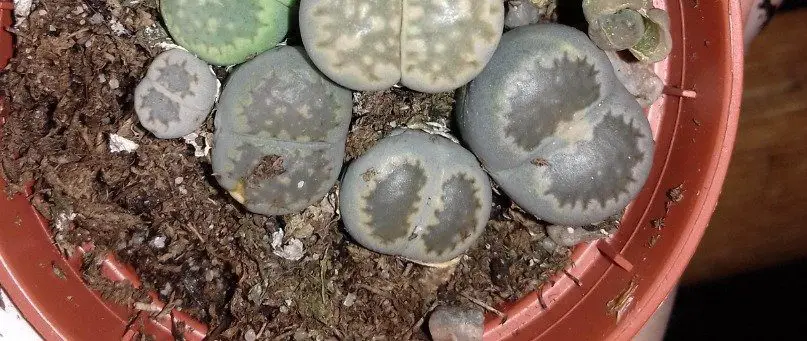Lithops are small succulent plants with many variations. The most common is called Lithops bromfieldii, which has a diamond-shaped body and two large leaves on either side. If you have ever grown lithops before, or if you have them in your garden now, then chances are that one day they will die from overwatering!
This post will teach you how to save overwatered lithops so that they can continue living their long lives of sunshine and rainbows.
How to Save Overwatered Lithops?
Step One – Remove the plant from its container. Pick up your dying plant by holding onto both leaves firmly near their base where they join together as one stem. Shake out all loose dirt from roots into a plastic bucket or a plastic bag. Pull the plant out of its container as you gently tug on it to loosen roots from rocks and soil.
Step Two – Clean your lithops once you have removed it from its old dirt and are certain no stray dirt clumps remain on top of either leaf’s surface. Next, go ahead and place them onto paper towels which will absorb any excess moisture left behind. You can use clean cotton swabs (Q-tips) or other small, pointy objects to reach into the crevices of each leaf’s surface and clear out any dirt that remains.
Step Three – Replant your lithops after inspecting the plant for damage during this cleaning process.
Step Four – Locate a place with bright indirect sunlight where your flowerpot can rest until the soil is completely dry. Lithops do best in warm climates, so if you can place your flowerpot on a window sill to receive indirect sunlight during this time period then they will be very happy!
If not and it’s wintertime where you live, or you don’t have access to an area with bright light for long periods of time, then just let them sit wherever inside until their dirt has dried up into hard clumps before returning them back outside again once conditions are acceptable.
Step Five – Let another week pass by without giving your lithop plant any water at all (and assuming that no one watered it accidentally). Continue to monitor soil moisture daily, and as soon as you notice it is beginning to dry up, then go ahead and water your lithops by slowly pouring only a small amount of water onto the plant’s surface so that the top inch of soil is moist.
Step Six – Let us now hope beyond hope that you never have need of this post/tutorial again!
What Does An Overwatered Lithop Look Like?
You can spot an overwatered lithop by the white dots that can be seen on top of the plant. This is a sign that its roots are rotting from too much moisture, and it often happens as a result of overwatering.
If you notice these white spots becoming larger in size at an alarming rate, then chances are your lithops have been over-watered for quite some time now!
You will also see that the lithop has become soft, instead of the firm structure it usually has. This also usually comes with a split lip on top of your lithop. This is a serious sign that it has been given far too much water.
Lithops are succulents, which means they store water in their leaves. This is why it’s very important that you only give them a small amount of water at once!
How To Tell If Your Lithop Needs Water?
If the soil has turned into hard clumps and your lithop feels light when you pick it up, then this usually indicates that its roots have dried out from lack of moisture – meaning no more watering for quite some time now.
Usually, if the plant was overwatered, chances are there will be condensation on top of both leaves after watering – especially if given too much at one time (when compared to putting just enough every other day). Always check for signs like these before giving any type of water to your lithop.
As a general rule of thumb, you should be giving small amounts of water once in every two weeks. But don’t ever let them sit in any standing puddle of water! Lithops are also very sensitive about being over-watered because they will die after getting too much moisture at one time – even from just watering twice within a week apart period.
Why is Overwatering Bad for Lithops?
Overwatering is bad for two reasons: firstly, if given too much water, then they can begin rotting and/or become infested with pests. Secondly, if watered too often in a short period of time, then they can begin to lose their stem along with the roots and eventually turn into just leaves.
Conclusion
In conclusion, take care not to water your lithops more than once every two weeks, and make sure you pour just enough for the soil to become moist. And if they start changing color and become mushy, then chances are they have been overwatered – which means no more water until conditions improve!
Tim is an avid gardener from the UK. He was the founder of PlantCarer.com from 2021 to Sep 2023. He sold PlantCarer.com to Aaron. He has since started his own business called Seed To Supper, which provides new gardeners all the materials you need in a box (pots, seeds, compost and instructions) to grow your own delicious and nutritious vegetables and herbs from start to finish – no garden required.

